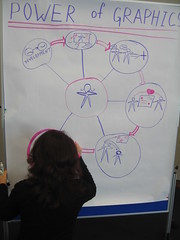 I have fallen deeply in love with graphic facilitation and graphic recording at face to face events. As the person doing the graphics, I listen much more deeply. That is saying something for someone who often talks a lot. But more than that, I have found that images are:
I have fallen deeply in love with graphic facilitation and graphic recording at face to face events. As the person doing the graphics, I listen much more deeply. That is saying something for someone who often talks a lot. But more than that, I have found that images are:
- …negotiable. Unlike words, where we make a silly assumption of accuracy, we are often comfortable asking about an image and entering easily into a conversation. This has been particularly important for me when working in intercultural settings where figuring out if we are all talking about the same or different things is REALLY important. Stories are conversation starters and help us make meaning.
- …validating. When someone takes the time to draw pictures about what someone said, they feel heard and validated. They tend to really enjoy seeing the visual artifact of their words or presentation and often take it with them. Pictures about us make us feel special. (I know that can sound a bit precious. But give me some slack!)
- …stimulate memories. Often graphic recordings of events make little sense to those who weren’t at the event. But when they hinge upon a central image or metaphor, they help us remember an event or a conversation. They are an interesting reification of what happened. Pictures help us remember.
- …anchor stories. When I have to explain what went on in a meeting, I love having the graphic recordings to tell the story. They prompt me through the key moments and conclusions. This can also be done with a slide show of photographic images. Photos help us tell stories.
As a result of my love affair with images, I now:
- try to embed a picture in every blog post
- link to pictures in delicious and Twitter
- embed images in discussion forums and email threads
- bring paper and pens to share at all face to face events.
What are you seeing in your practices?
I haven’t tried drawing sketches like you do of what people say, but the practice seems excellent. I do use a lot of images – visual and music. My talks are (in)famous for not having many words written on foils – mostly the foils are photos or drawings that I talk to. I even use stylized hand-drawn graphs to make points.
Music can be important. One company I work with assigns theme songs to external speakers before they talk. I sometimes do that, but audio interludes can be a powerful addition to the story telling. (now if I was only a better story teller!) I did teach a seminar at Oberlin that Jab Abumrad took – there is someone who knows how to combine storytelling and non-verbal audio.
Putting words on VGs is bad form as people tend to read them and have their minds wander. Worse yet speakers tend to read them and decouple from the audience.
I’m not terribly good about the use of images on my blog, but Colleen does an excellent job http://www.6footsix.com/ – there is a lot of thought that goes into each one.